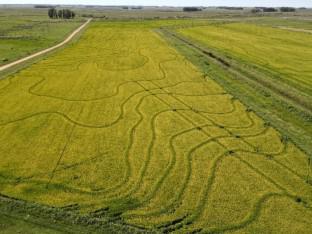Precision Agriculture ( IF 5.4 ) Pub Date : 2022-08-24 , DOI: 10.1007/s11119-022-09946-8 M. Bueno , A. Roel , L. Faria , J. Massey , J. Parfitt

|
During land leveling topsoil of relative higher elevation zones are removed (cut) and deposited in relative lower elevation zones (fill), this operation could have negative impacts on soil conservation and potentially can affect productivity. Although land leveling is an efficient way of increasing water use efficiency and irrigation uniformity, it can be rather expensive and, in some cases, a significant movement of earth may be required. Nowadays, with the technological advancement a new option is available called Land-forming for irrigation (LFI). This alternative method potentially allows smaller soil movement and consequently smaller cutting depths while improving irrigation and drainage conditions without affecting productivity. The hypothesis of this study was that applying LFI can allow a more efficient irrigation than the commonly used procedure done by farmers (Control: no alteration of natural topography) without affecting productivity. For achieving this, a 2-year 2019/2020 and 2020/2021 rice seasons comparison study was done in a semi-commercial field (12 ha) in Uruguay. This was the first time LFI was implemented in this country. For achieving the LFI alternative a soil movement of 104 m3 ha−1 was determined. The depth of cut was in average 0.03 m, with a maximum cut of 0.16 m. The total length and number of rice levees were reduced by 14% and 28%, respectively, compared to the situation this same field would be level using the traditional system (no alteration of original topography). Irrigation water moved across the LFI field more quickly and uniformly as compared to the Control. For both years of the study, there were no differences (P > 0.05) in field-average grain yields between the LFI and Control treatments even though yield increases, and yield decreases were often associated with specific fill and cut zones, respectively. When data from both seasons are pooled together a significant relation was detected (% yield deviation = 0.81 + 140*cut depth, m). Taken together, this work demonstrates that, by limiting the amount of soil moved as part of the land forming process, LFI can provide the level of rice productivity as traditional leveling practices common to South America while improving irrigation distribution uniformity, setting the stage for improved furrow irrigation of rotational crops such as soybean.
中文翻译:

在低地土壤上进行土地整地灌溉 (LFI) 可保护水稻产量,同时提高灌溉分配的均匀性
在土地平整过程中,相对较高海拔地区的表土被移除(切割)并沉积在相对较低海拔地区(填充),这种操作可能对土壤保持产生负面影响,并可能影响生产力。尽管土地平整是提高用水效率和灌溉均匀性的一种有效方式,但它可能相当昂贵,在某些情况下,可能需要大量的土方运动。如今,随着技术的进步,一种称为土地形成灌溉(LFI)的新选项可用。这种替代方法可能允许更小的土壤移动,因此可以更小的切割深度,同时改善灌溉和排水条件而不影响生产力。本研究的假设是,与农民常用的程序相比,应用 LFI 可以实现更有效的灌溉(对照:不改变自然地形),而不会影响生产力。为了实现这一目标,在乌拉圭的一个半商业领域(12 公顷)进行了为期 2 年的 2019/2020 和 2020/2021 水稻季节比较研究。这是该国首次实施 LFI。为了实现 LFI 替代方案,土壤运动为 104 m3 公顷-1被确定了。切削深度平均为 0.03 m,最大切削深度为 0.16 m。与使用传统系统(不改变原始地形)在同一田地的情况相比,稻田的总长度和数量分别减少了 14% 和 28%。与对照相比,灌溉水更快更均匀地流过 LFI 田地。在研究的这两年中,即使产量增加,LFI 和对照处理之间的田间平均谷物产量也没有差异 (P > 0.05),而产量下降通常分别与特定的填土和切割区域有关。当两个季节的数据汇集在一起时,检测到显着的关系(%产量偏差 = 0.81 + 140 * 切割深度,m)。综上所述,这项工作表明,







































 京公网安备 11010802027423号
京公网安备 11010802027423号